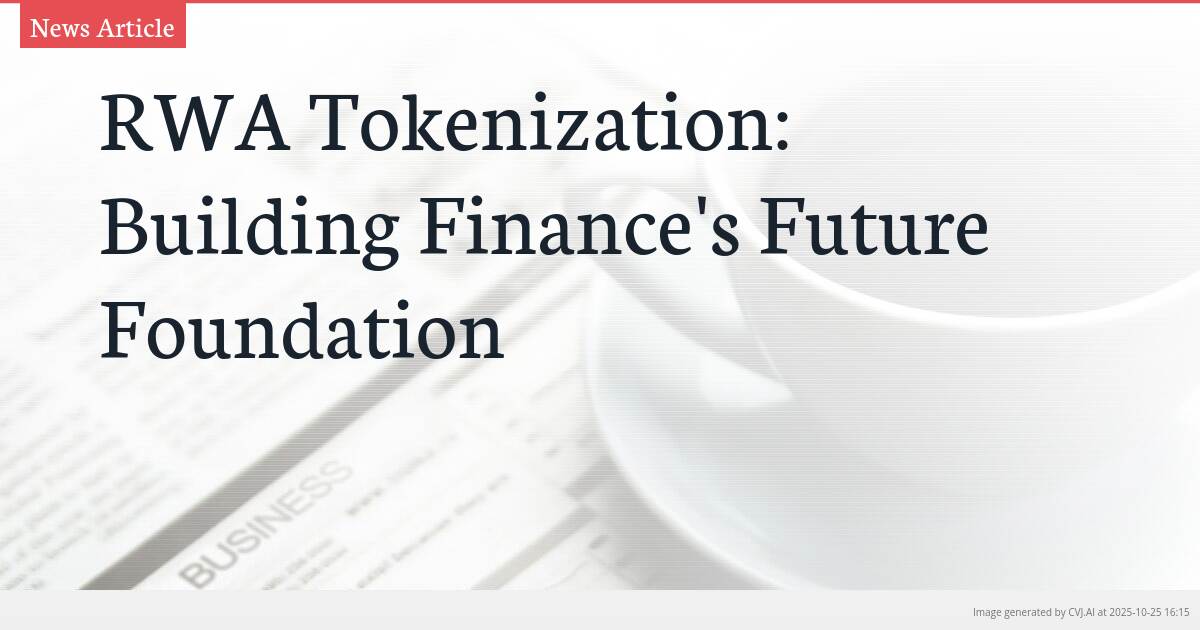This summary text is fully AI-generated and may therefore contain errors or be incomplete.
Introduction
Real-world asset tokenization faces significant criticism despite showing clear progress and value. Regulatory clarity and growing institutional adoption are building the foundation for finance’s future, according to industry experts. While critics argue that decentralization alone should suffice, the reality is more complex, with RWA tokenization establishing itself as a transformative force in financial markets despite ongoing scrutiny.
Key Points
- RWA tokenization faces criticism despite showing clear value and progress
- Regulatory clarity and institutional adoption are key drivers for future success
- Decentralization alone is insufficient according to industry experts
The Criticism and Pressure Facing RWA Tokenization
Real-world asset (RWA) tokenization is currently operating under immense pressure to perform, despite demonstrating clear value and showing progressive development. According to Alex Zhang, co-founder at Pharos, the criticism leveled at RWA tokenization is substantial, with some critics maintaining that decentralization alone should be sufficient to address traditional finance challenges. This perspective, however, fails to capture the nuanced reality of financial innovation.
The pressure on RWA tokenization comes from multiple fronts: traditional financial institutions seeking proven returns, crypto-native communities demanding pure decentralization, and regulators requiring compliance frameworks. Despite these competing demands, the technology continues to advance, demonstrating tangible benefits in asset liquidity, fractional ownership, and operational efficiency. The criticism often overlooks the practical progress being made in bridging traditional finance with blockchain technology.
Regulatory Clarity as a Critical Enabler
One of the most significant factors driving RWA tokenization forward is the emergence of regulatory clarity across key jurisdictions. As financial authorities worldwide develop frameworks for digital assets, the path becomes clearer for institutional participation in tokenized real-world assets. This regulatory evolution is essential for building trust and ensuring compliance in what remains a highly regulated financial landscape.
The progression of regulatory frameworks enables traditional financial institutions to engage with RWA tokenization with greater confidence. Clear guidelines around custody, transferability, and legal ownership of tokenized assets remove significant barriers to adoption. This regulatory maturation represents a crucial foundation for the sustainable growth of RWA tokenization, allowing it to move beyond experimental phases into mainstream financial applications.
Institutional Adoption and Market Evolution
Growing institutional adoption is proving to be another cornerstone in the development of RWA tokenization’s future. Major financial institutions are increasingly exploring and implementing tokenization solutions for assets ranging from real estate and commodities to intellectual property and fine art. This institutional interest validates the technology’s potential while providing the capital and credibility needed for broader market acceptance.
The involvement of established financial players brings not only capital but also operational expertise and market infrastructure. As institutions like Pharos and others develop sophisticated tokenization platforms, they’re creating the necessary ecosystem for RWA tokenization to thrive. This institutional participation helps bridge the gap between traditional finance and decentralized finance (DeFi), creating hybrid models that leverage the strengths of both systems.
Beyond One-Dimensional Solutions
Alex Zhang emphasizes that tokenizing real-world assets is not a self-contained solution to traditional finance problems, calling such claims one-dimensional. The reality is that RWA tokenization represents one component in a broader financial evolution, working alongside other innovations to create more efficient, accessible, and transparent markets. This nuanced understanding is crucial for properly evaluating the technology’s potential and limitations.
The integration of RWA tokenization into existing financial systems requires careful consideration of multiple factors, including legal frameworks, market infrastructure, and user adoption. Rather than replacing traditional finance entirely, RWA tokenization is evolving as a complementary technology that enhances certain aspects of asset management and transfer. This balanced approach acknowledges both the transformative potential and practical constraints of the technology.
As the financial landscape continues to evolve, RWA tokenization is positioned to play an increasingly important role in shaping how real-world assets are managed, transferred, and valued. While challenges remain and criticism persists, the combination of regulatory progress, institutional adoption, and technological advancement suggests that RWA tokenization is indeed building a foundation for finance’s future—one that acknowledges complexity rather than seeking simplistic solutions.
📎 Read the original article on cointelegraph.com

